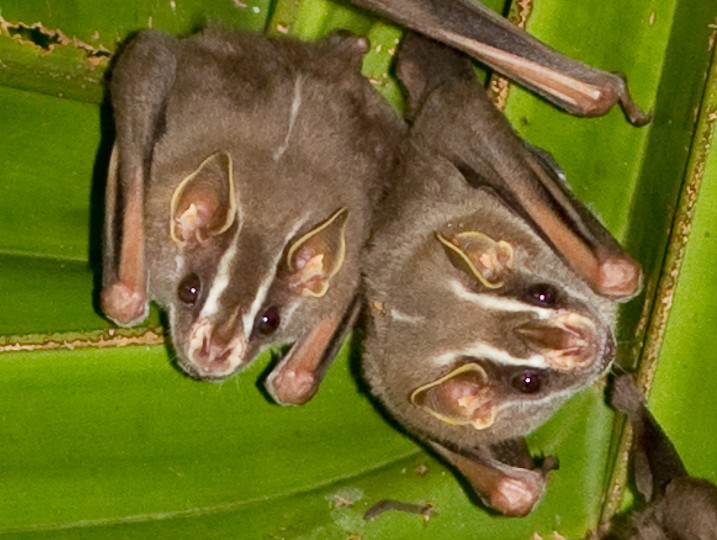Tent-making bat
A species of Uroderma Scientific name : Uroderma bilobatum Genus : Uroderma
Tent-making bat, A species of Uroderma
Scientific name: Uroderma bilobatum
Genus: Uroderma
Content
Description General Info
 Photo By Brian Gratwicke , used under CC-BY-2.0 /Cropped and compressed from original
Photo By Brian Gratwicke , used under CC-BY-2.0 /Cropped and compressed from original Description
Uroderma bilobatum is medium in size, weighing between 13–20 g with a body length of 59–69 mm. Typically, the females are slightly larger than the males. Their pelage ranges in color from dark gray to grayish brown, with their belly slightly lighter in color than their back. The individual hairs of their coat are bicolor, being lighter in color at the base than at the top. A thin, white stripe runs down the middle of the back from behind the head to the rump. The face has two striking symmetrical pairs of white stripes. One pair goes over the head, between and to the back of the ears. The other pair lies just below the eye. This facemask may serve a camouflage purpose by making their eyes less obvious to would-be predators. Their brown noseleaf and ears are rimmed with yellow or white. They have a U-shaped tail membrane that is practically hairless and measures 14–16 mm in length. A dorsal view of their skull reveals a depression between the frontal bone and their snout. Their dental formula is i 2/2, c 1/1, p 2/2, m 3/3, which gives them a total of 32 teeth. They also possess a calcar and a slightly pigmented, permanently open dactylopatagium minus. 
General Info
Lifespan
6-10 years
Diet
Tent-making bat is primarily a frugivore, with its diet revolving around fruits, particularly figs. Additionally, this bat species also feeds on arthropods, supplementing its diet with needed proteins. Its unique foraging habit includes 'gleaning' from foliage.
Appearance
Tent-making bat is a small-sized flying mammal with a slender body covered in soft, velvety fur. Its primary coloration is dark grey, with a conspicuous white stripe down its back that extends into two lobes, giving it a unique 'Y' shape. It boasts large eyes and ears, a short, leaf-shaped nose, and a tail membrane. There are no significant differences in appearance due to age, gender, or subspecies.
Behavior
As noted in their common name, Uroderma bilobatum exhibits a curious roosting behavior. They bite through the midrib or vein of a large leaf so that it folds in half to form an inverted-V-shaped shelter. This “tent” provides shelter from sun, wind, and rain. Eventually, the leaf dries up and breaks off from the plant, and they have to construct a new one, a feat that takes them several nights to accomplish. Amazingly, a single tent may be used for up to 60 days. U. bilobatum prefers the large, single leaves of banana trees and pinnate or palmate palms. They may roost in groups of 2–59 individuals, and are quite easily startled from their roosts during the day. They tend to choose tall trees, but not the tallest trees in the area. Taller trees may offer them greater protection from predators, but trees that are too tall would mostly likely expose them to greater winds. An additional preference has been demonstrated for younger fronds, which are also usually further from the ground. Due to the nature of their roosts, foliage-roosting bats tend to be more nomadic than bats that roost in caves. Some suggest that this adaptation may enable them to track food sources throughout the seasons. The tents may also provide protection from predators that target typical bat roosts such as caves and hollow trees. However, the disadvantages of such a lifestyle include the energetic costs that the bats have to expend in the creation of new tents every few months and the decreased protection from the weather offered by such roosts. 
Population
Stable
Scientific Classification
Phylum
Chordates Class
Mammals Order
Bats Family
Leaf-nosed bat Genus
Uroderma Species
Tent-making bat